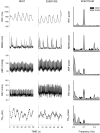Dynamic carotid baroreflex control of the peripheral circulation during exercise in humans
- PMID: 15235090
- PMCID: PMC1665122
- DOI: 10.1113/jphysiol.2004.066183
Dynamic carotid baroreflex control of the peripheral circulation during exercise in humans
Abstract
We sought to determine the dynamic relationship between carotid baroreflex (CBR)-mediated control and local control of the skeletal muscle vasculature during dynamic exercise. In 12 subjects (18-35 years old), oscillatory neck pressure (NP, +40 mmHg) was applied at 0.1 Hz (i.e. 5 s on, 5 s off) for 5 min to determine the degree of CBR control over heart rate (HR), arterial blood pressure (ABP), muscle sympathetic nerve activity (MSNA), femoral blood velocity and skeletal muscle tissue oxygenation at rest and during 7 W dynamic knee-extension exercise. Skeletal muscle tissue oxygenation measurements of both the exercising and nonexercising leg were evaluated. Fast Fourier transformation was performed on 5 min segments to calculate spectral power of the R-R interval (RRI), ABP, MSNA, femoral blood velocity and tissue oxygenation time series, and the low-frequency (LF, 0.085-0.115 Hz) power spectra were compared to evaluate the degree of CBR-mediated entrainment for each variable. At rest, sinusoidal NP significantly increased LF spectral power of RRI, ABP, MSNA and femoral blood velocity. During exercise, sinusoidal NP provoked a similar increase in spectral power for RRI and MSNA, while CBR-mediated changes in ABP and femoral blood velocity were attenuated compared to rest. Changes in spectral power of skeletal muscle tissue oxygenation during sinusoidal NP were similar between the exercising and nonexercising leg at rest. However, during exercise the changes in skeletal muscle tissue oxygenation power were significantly less in the exercising leg, while changes in the nonexercising leg were similar to rest. We have demonstrated simultaneous entrainment of all CBR end-organ measurements, ranging from cardiac chronotropic effects to alterations at the level of the skeletal muscle microcirculation. Moreover, we have identified a significant and specific attenuation of end-organ responsiveness to CBR-mediated sympathoexcitation in the vasculature of the exercising muscle. However, despite a shift towards more predominant local control over the exercising muscle vasculature, systemic arterial blood pressure was well preserved.
Figures





Similar articles
-
Inhibition of KATP channel activity augments baroreflex-mediated vasoconstriction in exercising human skeletal muscle.J Physiol. 2004 Nov 15;561(Pt 1):273-82. doi: 10.1113/jphysiol.2004.071993. Epub 2004 Sep 2. J Physiol. 2004. PMID: 15345750 Free PMC article. Clinical Trial.
-
Carotid baroreflex control of leg vasculature in exercising and non-exercising skeletal muscle in humans.J Physiol. 2004 Nov 15;561(Pt 1):283-93. doi: 10.1113/jphysiol.2004.071944. Epub 2004 Sep 23. J Physiol. 2004. PMID: 15388778 Free PMC article.
-
Carotid baroreflex control of leg vascular conductance at rest and during exercise.J Appl Physiol (1985). 2003 Feb;94(2):542-8. doi: 10.1152/japplphysiol.00817.2002. Epub 2002 Oct 18. J Appl Physiol (1985). 2003. PMID: 12391067
-
Arterial baroreflex control of the peripheral vasculature in humans: rest and exercise.Med Sci Sports Exerc. 2008 Dec;40(12):2055-62. doi: 10.1249/MSS.0b013e318180bc80. Med Sci Sports Exerc. 2008. PMID: 18981944 Review.
-
Skeletal muscle blood flow in humans and its regulation during exercise.Acta Physiol Scand. 1998 Mar;162(3):421-36. doi: 10.1046/j.1365-201X.1998.0293e.x. Acta Physiol Scand. 1998. PMID: 9578388 Review.
Cited by
-
Inhibition of KATP channel activity augments baroreflex-mediated vasoconstriction in exercising human skeletal muscle.J Physiol. 2004 Nov 15;561(Pt 1):273-82. doi: 10.1113/jphysiol.2004.071993. Epub 2004 Sep 2. J Physiol. 2004. PMID: 15345750 Free PMC article. Clinical Trial.
-
The influence of the carotid baroreflex on dynamic regulation of cerebral blood flow and cerebral tissue oxygenation in humans at rest and during exercise.Eur J Appl Physiol. 2018 May;118(5):959-969. doi: 10.1007/s00421-018-3831-1. Epub 2018 Mar 1. Eur J Appl Physiol. 2018. PMID: 29497836
-
Arterial-cardiac baroreflex function: insights from repeated squat-stand maneuvers.Am J Physiol Regul Integr Comp Physiol. 2009 Jul;297(1):R116-23. doi: 10.1152/ajpregu.90977.2008. Epub 2009 May 6. Am J Physiol Regul Integr Comp Physiol. 2009. PMID: 19420293 Free PMC article.
-
Transfer function characteristics of the neural and peripheral arterial baroreflex arcs at rest and during postexercise muscle ischemia in humans.Am J Physiol Heart Circ Physiol. 2009 May;296(5):H1416-24. doi: 10.1152/ajpheart.01223.2008. Epub 2009 Mar 13. Am J Physiol Heart Circ Physiol. 2009. PMID: 19286945 Free PMC article.
-
Noninvasive detection of the hemodynamic stress of exercise using the photoplethysmogram.J Clin Monit Comput. 2008 Aug;22(4):269-78. doi: 10.1007/s10877-008-9129-9. Epub 2008 Jun 25. J Clin Monit Comput. 2008. PMID: 18584296
References
-
- Andersen P, Adams RP, Sjogaard G, Thorboe A, Saltin B. Dynamic knee extension as model for study of isolated exercising muscle in humans. J Appl Physiol. 1985;59:1647–1653. - PubMed
-
- Anderson KM, Faber JE. Differential sensitivity of arteriolar alpha 1- and alpha 2-adrenoceptor constriction to metabolic inhibition during rat skeletal muscle contraction. Circ Res. 1991;69:174–184. - PubMed
-
- Bernardi L, Hayoz D, Wenzel R, Passino C, Calciati A, Weber R, Noll G. Synchronous and baroceptor-sensitive oscillations in skin microcirculation: evidence for central autonomic control. Am J Physiol. 1997;273:H1867–H1878. - PubMed
Publication types
MeSH terms
Grants and funding
LinkOut - more resources
Full Text Sources
Medical
Miscellaneous

